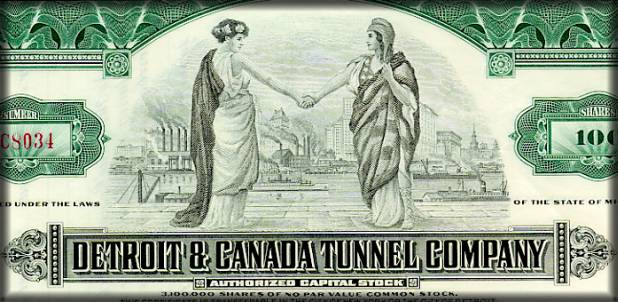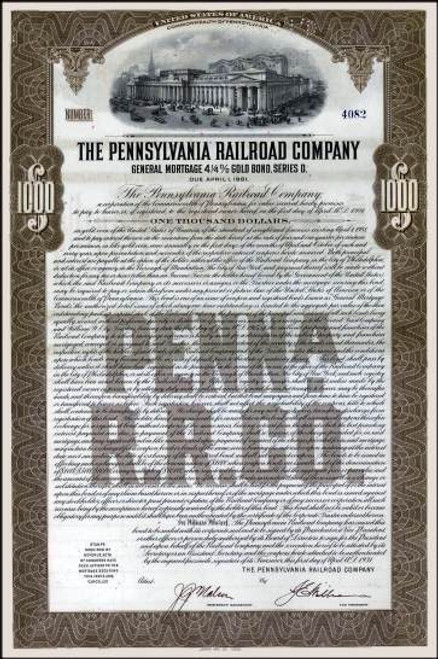Beautifully engraved certificate from the Detroit & Canada Tunnel Company issued no later than 1931. This historic document was printed by the Central Banknote Company and has an ornate border around it with a vignette of an American woman shaking the hand of a Canadian woman. This item has the printed signatures of the company's president ( Judson Bradway ) and secretary ( A. Garden ) and is over 75 years old. The certificate is in excellent condition. 
Certificate Vignette The Detroit-Windsor Tunnel is the only underwater international vehicular (automobile) tunnel in the world. Completed in 1930, the tunnel is a major border crossing and a vital socio-economic pipeline between the United States and Canada. Prior to its construction and that of the Ambassador Bridge one year earlier, cars and trucks crossed the Detroit River on car ferries. This cutaway shows how the tunnel drops down from Detroit, right, goes under the river and surfaces again in Windsor. Early in the 19th Century Detroiters expressed the need for both a tunnel and bridge to speed rail transportation across the river but well-organized opposition by marine shipping interests blocked any such project. Finally in 1871, ground was broken on a rail tunnel project near the foot of Detroit's St. Antoine Street. The railroad tunnel had a 15-foot bore, and at 135 feet under the river, workmen struck a pocket of sulphurous gas which made them deathly ill. The project was abandoned when none of the workers could be enticed to return to work. Eight years later work began on another tunnel that would connect Grosse Ile with Canada. The Michigan Central Railroad already had a bridge that connected Grosse Ile with the U.S. mainland. But expenses soared as unexpected limestone formations were encountered. Once again, the tunnel project was abandoned. When the Grand Trunk Railroad Tunnel under the St. Clair river at Port Huron opened in 1891, Detroit businessmen who feared that shipping of goods would be diverted to Port Huron demanded a tunnel be built at Detroit. The approaches were built as conventional box subways with the cut and cover method. This is the Canadian side. As a result, construction of the Michigan Central Railway Tunnel was begun in 1906 and was completed by 1910. The phenomenal growth of the automobile industry after the end of World War I caused renewed interest in another tunnel between Detroit and Windsor. In 1919, Detroit Mayor James Couzens, and Windsor Mayor E. Blake Winter, proposed construction of a tunnel for automobile and streetcar traffic as a memorial to the war dead. The idea was immediately popular with patriots on both sides of the river. But bureaucratic bickering and opposition from forces who planned to build the Ambassador Bridge threatened the project. But tunnel partisans refused to be defeated. One such visionary, Fred W. Martin, a Windsor Salvation Army Captain, said in a Detroit News article, that he was "inspired by God to have this tunnel built." But he didn't go to God. Instead he went to New York and convinced an architectural and engineering firm that "it would probably be six dozen Sundays or more before the politicians would agree on anything, so how about taking a flyer on this as a private project?" The firm, Parsons, Klapp, Brinckerhoff and Douglas, agreed to design the tunnel and guarantee its costs. Detroit, New York and Chicago bankers backed the the project. The underwater portion of the tunnel used these tube sections that were connected together above ground and then towed out into the river and sunk in place. And so it came to be the Detroit Windsor Tunnel emerged privately financed, privately built, and privately operated Russell Armstrong Sr, a consulting engineer and surveyor in Windsor, agreed to do the surveying of the Windsor side and to obtain the necessary land titles. Armstrong did not get rich on the deal. "It was a very challenging time", he said. "The Ambassador Bridge was going up just before the tunnel started and there was a sort of a race to see who would finish first. The bridge won, but I still like the tunnel better." Judson Bradway, an ambitious supporter of the tunnel project and a successful businessman, won the appointment as the first president of the Detroit & Canada Tunnel Company as well as its subsidiary, the Detroit & Windsor Subway Company . Actual construction operations began in the summer of 1928 on both sides of the river. Because the international nature of the tunnel required customs and immigration offices, more than 25 buildings in addition to the tunnel had to be built. Steam shovels gulped the first bites of dirt in the $25 million project in May 1928. As workers on the U.S. and Canadian sides excavated approach tunnels sloping to the river's edge, barge crews on the river dug a 2,454-foot-long trench from shore to shore, dredging 700,000 tons of earth from the river bottom. The tubes have a diameter of 31 feet and are composed of 3/8"-thick steel plate reinforced at 12-foot intervals by octagonal diaphragms which also provide the form for an exterior concrete jacket. Using a 32-foot shield, the largest in North America at the time, the tunnelers, called "muckers" or "sandhogs," sliced away the sticky, gray clay with air-driver knives and passed it back through the shield to to others who moved it to the dump. The shield moved forward, pushed by 30 hydraulic jacks, at the rate of eight or ten feet a day. Behind it, workers lined the freshly excavated tunnel sides with steel plating. The river section was constructed by the "trench-and-tube" method. It was the most spectacular of all tunnel operations and involved the sinking of steel tubes in the trench dug across the bottom of the river. Steel and concrete tubes towed into the river on barges,were sunk into the trench. There were nine sections of tube, each 250 feet long and weighing 8,000 tons. After the tubes were laid in the trench divers bolted the sections end-to-end, and cemented the joints. Ventilation towers at each end of the tunnel remove vehicle exhaust and replace it with fresh air. Huge fans blow fresh air into the Tunnel through a duct below the roadway and suck stale air and exhaust out through ducts above the ceiling. Dedication ceremonies took place on a crisp autumn day Nov. 1,1930. Detroit Mayor Frank Murphy hailed it as "a new appreciation of our desire to preserve peace, friendship and the brotherhood of man." One of the huge fans that help ventilate the tunnel. Windsor Mayor Frederick Jackson said it was "almost incredible that we will be able to pass from the one great country to the other in the short space of three minutes". As the oratory ended on both sides of the river, President Herbert Hoover pushed a golden botton in the White House that started bells ringing at the speakers' platforms on both sides of the tunnel. The first driver through the tunnel on that Saturday was construction worker, Joseph Zuccatto. At the time Zuccatto was making 35 cents a hour at his tunnel job. When the tube under the Detroit River was ready, he drove his cement truck from Windsor to Detroit and then back again just to make sure everything was all right. "On that Saturday,," Zuccatto later recalled, "when I was the first guy to drive back and forth, I was a VIP for about six hours. There was beer and champagne and fried chicken. I must have shook hands a hundred times, and maybe I got a little drunk, but it was a special day." Ernie Robinson, of Windsor was 25 when they started hiring sand hogs to get down in the tunnel and start clearing away the muck and clay. He made a whopping 75 cents a hour, chipping away at the walls and shoveling dirt into a cart. Said Robinson later at the 50th anniversary of the Tunnel, "A mole has some pride after he finishes digging a hole, doesn't he? Well, so do I." More than 20,000 vehicles travel the mile-long tunnel on a average day. More than 20,000 vehicles use the mile-long tunnel each day. In 1990 ownership of the Canadian half of the Detroit-Windsor Tunnel reverted to the city of Windsor, ending a 60 year franchise agreement with the Detroit & Canada Tunnel Corp. The Detroit side remains in private hands. In 1978 the city of Detroit, granted the company a 30-year lease extension to smooth the way for construction of the Renaissance Center. The tunnel company gave up rights-of-way ownership to streets where the RenCen now stands in exchange for a tax break and construction of a new Detroit tunnel plaza. Tunnel facts: The Detroit-Windsor tunnel is the only international subaqueous tunnel in the world. The tunnel is approximately one mile long from portal to portal. Supervising and design engineers were Parsons, Klapp, Brinckerhoff and Douglas. This firm also built the Holland Tunnel in New York. General contractors were the Parklap Construction Company and Porter Brothers and Robert Porter of Spokane, Wash. Burnside A. Value was the executive engineer and Soren A. Thoresen served as engineer of design. Construction took 26 months to complete -- 10 months quicker than had been anticipated. The tunnel opened for traffic November 3, 1930. The first car through was a 1929 Studebaker touring car. The tunnel roadway is 22 feet wide and allows for two lanes of traffic in opposite directions. The wearing course originally was laid with 2,000,000 granite blocks. These were removed when the roadway was paved with asphalt in 1977. The granite blocks are currently stored at the Fort Wayne Historical Museum. A million and a half cubic feet of air is pumped through the tunnel each minute. The air changes completely every 90 seconds. Approximately 250,000 tiles were used to line the walls of the Tunnel.

Certificate Vignette










